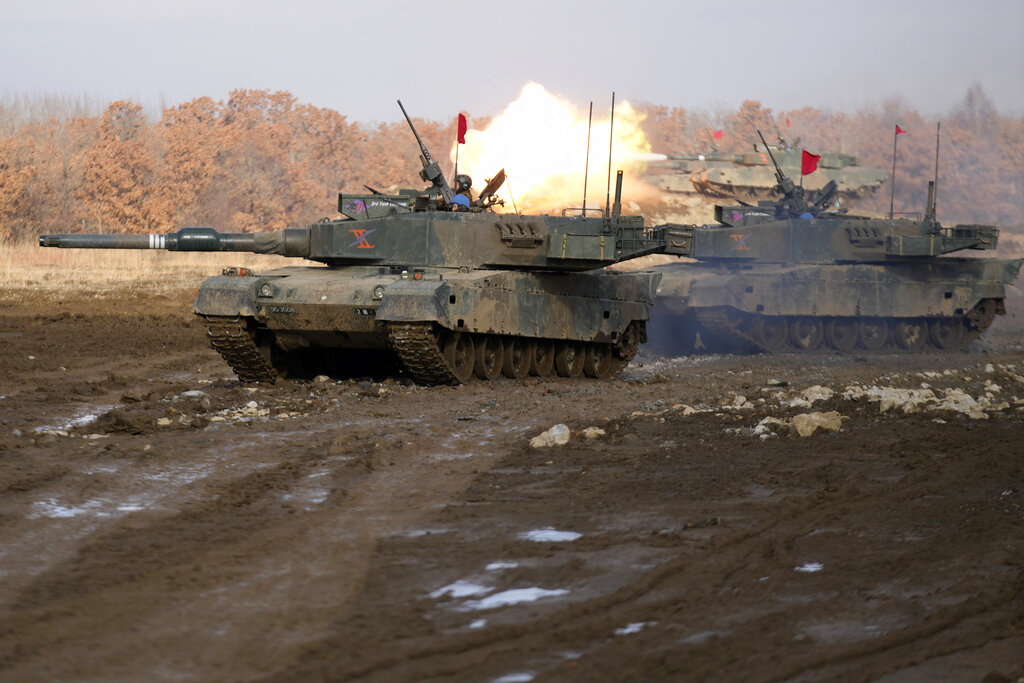THE ASSOCIATED PRESS
Dozens of tanks and Soldiers fired explosives and machine guns while participating in drills on December 6, 2021, on Japan’s northern island of Hokkaido, a main stronghold for a nation that is perhaps the world’s least-known military powerhouse.
Just across the sea from rival Russia, Japan opened its humbly named Self-Defense Force’s firing exercises to the media in a display of firepower that coincides with a recent escalation of Chinese and Russian military moves around Japanese territory.
The drills, which foreign journalists rarely have a chance to witness, continued for nine days and included 1,300 Ground Self-Defense Force troops. When the exercise opened, as hundreds of Soldiers cheered from the sidelines and waved unit flags, lines of tanks shot at targets meant to represent enemy missiles or armored vehicles. (Pictured: Japan Ground Self-Defense Force tanks fire at a target during an exercise on the island of Hokkaido.)
The exercises illuminated a fascinating, easy-to-miss point. Japan, despite an officially pacifist Constitution written when memories of World War II were still fresh, boasts a military that puts all but a few nations to shame.
And, with a host of threats lurking in Northeast Asia, its leaders are eager for more. It’s not an easy sell. In a nation still reviled by some neighbors for its past military actions, and where domestic pacifism runs high, any military buildup is controversial.
Japan has focused on its defensive capabilities and carefully avoids using the word “military” for its troops. But as it looks to defend its territorial and military interests against an assertive China, North Korea and Russia, officials in Tokyo are pushing citizens to put aside widespread unease over a more robust role for the military and support increased defense spending.
As it is, tens of billions of dollars each year have built an arsenal of nearly 1,000 warplanes and dozens of destroyers and submarines. Japan’s forces rival those of Britain and France and show no sign of slowing down in a pursuit of the best equipment and weapons money can buy.
Japan’s buildup comes as the People’s Republic of China (PRC) and Russia have stepped up military cooperation to counter growing U.S.-led regional partnerships.
In October 2021, a fleet of five warships each from the PRC and Russia circled Japan as they traveled through the Pacific to the East China Sea. Their warplanes then flew together in November near Japan’s airspace, causing Japanese fighter jets to scramble. Russia’s military also recently deployed coastal defense missile systems, the Bastion, near disputed islands off the northern coast of Hokkaido.
Japan was disarmed after its WWII defeat. But a month after the Korean War began in 1950, U.S. occupation forces in Japan created a 75,000-member lightly armed de facto army called the National Police Reserve. The Self-Defense Force, the country’s current military, was founded in 1954.
Today, Japan is ranked fifth globally in overall military power after the United States, Russia, the PRC and India, and its defense budget ranked sixth in the 2021 ranking of 140 countries by the Global Firepower rating site.
Japan has rapidly stepped up its military role in its alliance with Washington and has made more purchases of costly U.S. weapons and equipment, including fighter jets and missile interceptors.
“Japan faces different risks coming from multiple fronts,” said defense expert Heigo Sato, a professor at the Institute of World Studies at Takushoku University in Tokyo.
Among those risks are North Korea’s increased willingness to test high-powered missiles and other weapons, provocations by armed Chinese fishing boats and coast guard ships, and Russia’s deployment of missiles and naval forces.
One of North Korea’s missiles flew over Hokkaido, landing in the Pacific in 2017. In September 2021, another fell within the 200-nautical-mile exclusive economic zone off northwestern Japan.
Under a bilateral security pact, Japan hosts about 50,000 U.S. troops, mostly on the southern island of Okinawa, which, along with Japanese units in Hokkaido, are strategically crucial to the U.S. presence in the Pacific.
Japan has more than 900 warplanes, 48 destroyers, including eight Aegis missile-combating systems and 20 submarines. That exceeds Britain, Germany and Italy. Japan is also buying 147 F-35s, including 42 F-35Bs, making it the largest user of American stealth fighters outside of the United States, where 353 are to be deployed.

